University Engineering Leadership and Change Resistance Report
VerifiedAdded on 2020/03/16
|6
|1472
|127
Report
AI Summary
This report examines the critical role of engineering leadership in navigating change resistance within engineering projects. It highlights the importance of differentiating between management and leadership, emphasizing the proactive and innovative nature of effective leadership. The report delves into the challenges associated with change, including internal integration and external adaptation, and underscores the need for leaders to identify catalysts for change, such as technological advancements and market competition. It explores the roles of engineers as technical managers and leaders, emphasizing the use of transactional and democratic leadership qualities to ensure team engagement and productivity. Furthermore, the report outlines strategies for overcoming resistance to change, including creating a clear vision, seeking feedback, making motivational-driven announcements, and involving the workforce in finding solutions. It concludes by emphasizing the importance of communication, coaching, and the adoption of appropriate leadership approaches to reduce resistance and foster a successful change process.
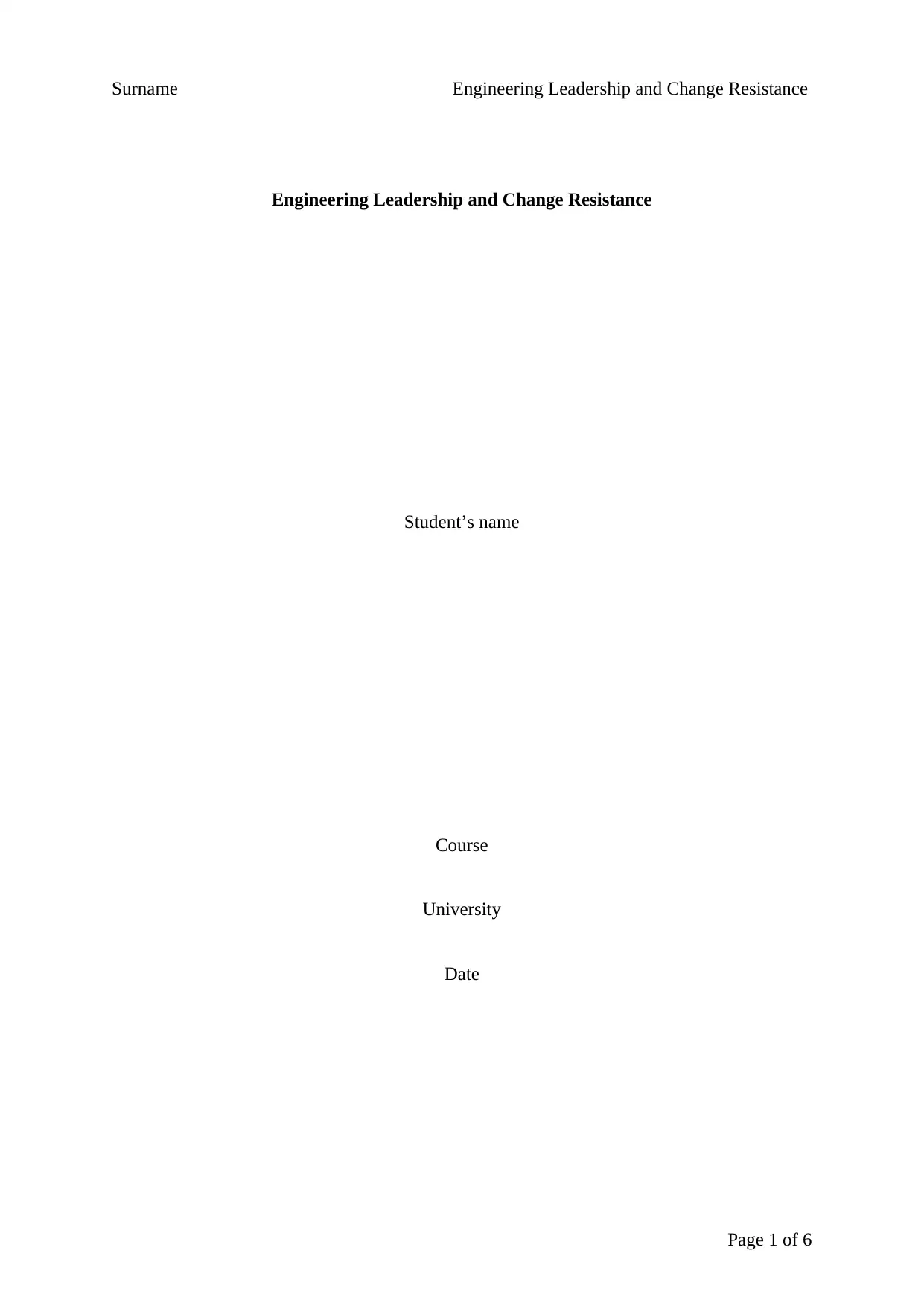
Surname Engineering Leadership and Change Resistance
Engineering Leadership and Change Resistance
Student’s name
Course
University
Date
Page 1 of 6
Engineering Leadership and Change Resistance
Student’s name
Course
University
Date
Page 1 of 6
Paraphrase This Document
Need a fresh take? Get an instant paraphrase of this document with our AI Paraphraser
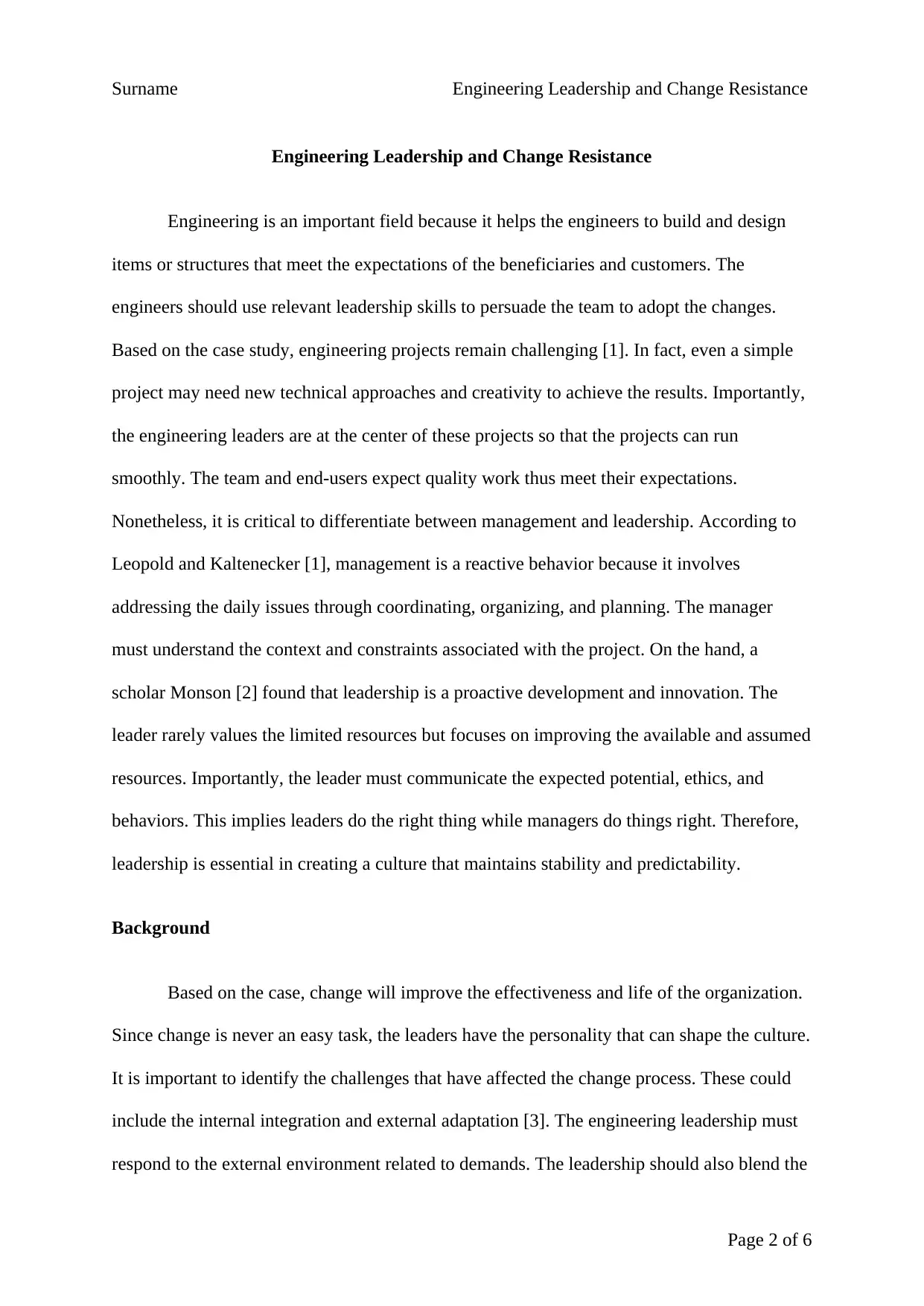
Surname Engineering Leadership and Change Resistance
Engineering Leadership and Change Resistance
Engineering is an important field because it helps the engineers to build and design
items or structures that meet the expectations of the beneficiaries and customers. The
engineers should use relevant leadership skills to persuade the team to adopt the changes.
Based on the case study, engineering projects remain challenging [1]. In fact, even a simple
project may need new technical approaches and creativity to achieve the results. Importantly,
the engineering leaders are at the center of these projects so that the projects can run
smoothly. The team and end-users expect quality work thus meet their expectations.
Nonetheless, it is critical to differentiate between management and leadership. According to
Leopold and Kaltenecker [1], management is a reactive behavior because it involves
addressing the daily issues through coordinating, organizing, and planning. The manager
must understand the context and constraints associated with the project. On the hand, a
scholar Monson [2] found that leadership is a proactive development and innovation. The
leader rarely values the limited resources but focuses on improving the available and assumed
resources. Importantly, the leader must communicate the expected potential, ethics, and
behaviors. This implies leaders do the right thing while managers do things right. Therefore,
leadership is essential in creating a culture that maintains stability and predictability.
Background
Based on the case, change will improve the effectiveness and life of the organization.
Since change is never an easy task, the leaders have the personality that can shape the culture.
It is important to identify the challenges that have affected the change process. These could
include the internal integration and external adaptation [3]. The engineering leadership must
respond to the external environment related to demands. The leadership should also blend the
Page 2 of 6
Engineering Leadership and Change Resistance
Engineering is an important field because it helps the engineers to build and design
items or structures that meet the expectations of the beneficiaries and customers. The
engineers should use relevant leadership skills to persuade the team to adopt the changes.
Based on the case study, engineering projects remain challenging [1]. In fact, even a simple
project may need new technical approaches and creativity to achieve the results. Importantly,
the engineering leaders are at the center of these projects so that the projects can run
smoothly. The team and end-users expect quality work thus meet their expectations.
Nonetheless, it is critical to differentiate between management and leadership. According to
Leopold and Kaltenecker [1], management is a reactive behavior because it involves
addressing the daily issues through coordinating, organizing, and planning. The manager
must understand the context and constraints associated with the project. On the hand, a
scholar Monson [2] found that leadership is a proactive development and innovation. The
leader rarely values the limited resources but focuses on improving the available and assumed
resources. Importantly, the leader must communicate the expected potential, ethics, and
behaviors. This implies leaders do the right thing while managers do things right. Therefore,
leadership is essential in creating a culture that maintains stability and predictability.
Background
Based on the case, change will improve the effectiveness and life of the organization.
Since change is never an easy task, the leaders have the personality that can shape the culture.
It is important to identify the challenges that have affected the change process. These could
include the internal integration and external adaptation [3]. The engineering leadership must
respond to the external environment related to demands. The leadership should also blend the
Page 2 of 6
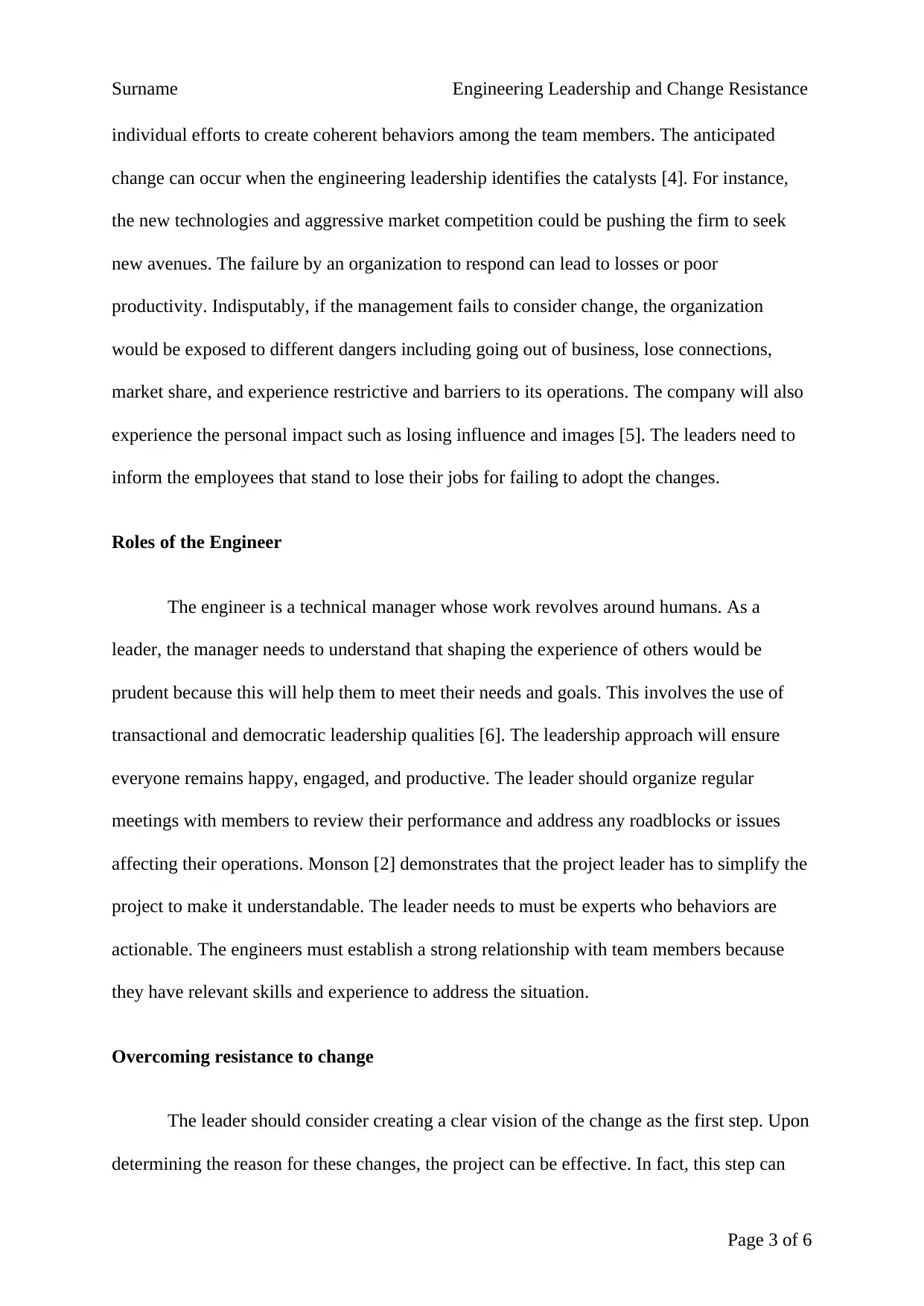
Surname Engineering Leadership and Change Resistance
individual efforts to create coherent behaviors among the team members. The anticipated
change can occur when the engineering leadership identifies the catalysts [4]. For instance,
the new technologies and aggressive market competition could be pushing the firm to seek
new avenues. The failure by an organization to respond can lead to losses or poor
productivity. Indisputably, if the management fails to consider change, the organization
would be exposed to different dangers including going out of business, lose connections,
market share, and experience restrictive and barriers to its operations. The company will also
experience the personal impact such as losing influence and images [5]. The leaders need to
inform the employees that stand to lose their jobs for failing to adopt the changes.
Roles of the Engineer
The engineer is a technical manager whose work revolves around humans. As a
leader, the manager needs to understand that shaping the experience of others would be
prudent because this will help them to meet their needs and goals. This involves the use of
transactional and democratic leadership qualities [6]. The leadership approach will ensure
everyone remains happy, engaged, and productive. The leader should organize regular
meetings with members to review their performance and address any roadblocks or issues
affecting their operations. Monson [2] demonstrates that the project leader has to simplify the
project to make it understandable. The leader needs to must be experts who behaviors are
actionable. The engineers must establish a strong relationship with team members because
they have relevant skills and experience to address the situation.
Overcoming resistance to change
The leader should consider creating a clear vision of the change as the first step. Upon
determining the reason for these changes, the project can be effective. In fact, this step can
Page 3 of 6
individual efforts to create coherent behaviors among the team members. The anticipated
change can occur when the engineering leadership identifies the catalysts [4]. For instance,
the new technologies and aggressive market competition could be pushing the firm to seek
new avenues. The failure by an organization to respond can lead to losses or poor
productivity. Indisputably, if the management fails to consider change, the organization
would be exposed to different dangers including going out of business, lose connections,
market share, and experience restrictive and barriers to its operations. The company will also
experience the personal impact such as losing influence and images [5]. The leaders need to
inform the employees that stand to lose their jobs for failing to adopt the changes.
Roles of the Engineer
The engineer is a technical manager whose work revolves around humans. As a
leader, the manager needs to understand that shaping the experience of others would be
prudent because this will help them to meet their needs and goals. This involves the use of
transactional and democratic leadership qualities [6]. The leadership approach will ensure
everyone remains happy, engaged, and productive. The leader should organize regular
meetings with members to review their performance and address any roadblocks or issues
affecting their operations. Monson [2] demonstrates that the project leader has to simplify the
project to make it understandable. The leader needs to must be experts who behaviors are
actionable. The engineers must establish a strong relationship with team members because
they have relevant skills and experience to address the situation.
Overcoming resistance to change
The leader should consider creating a clear vision of the change as the first step. Upon
determining the reason for these changes, the project can be effective. In fact, this step can
Page 3 of 6
⊘ This is a preview!⊘
Do you want full access?
Subscribe today to unlock all pages.

Trusted by 1+ million students worldwide
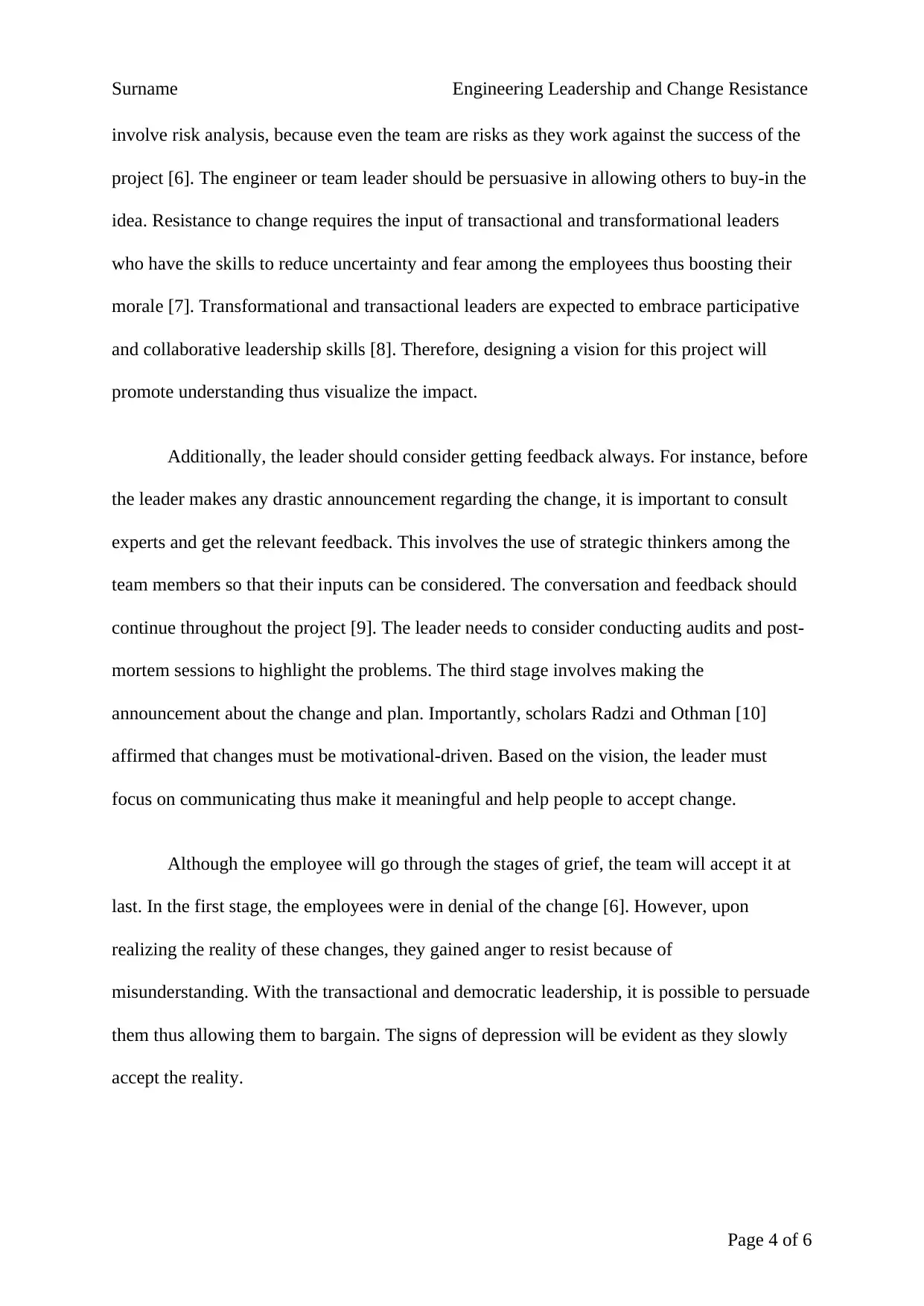
Surname Engineering Leadership and Change Resistance
involve risk analysis, because even the team are risks as they work against the success of the
project [6]. The engineer or team leader should be persuasive in allowing others to buy-in the
idea. Resistance to change requires the input of transactional and transformational leaders
who have the skills to reduce uncertainty and fear among the employees thus boosting their
morale [7]. Transformational and transactional leaders are expected to embrace participative
and collaborative leadership skills [8]. Therefore, designing a vision for this project will
promote understanding thus visualize the impact.
Additionally, the leader should consider getting feedback always. For instance, before
the leader makes any drastic announcement regarding the change, it is important to consult
experts and get the relevant feedback. This involves the use of strategic thinkers among the
team members so that their inputs can be considered. The conversation and feedback should
continue throughout the project [9]. The leader needs to consider conducting audits and post-
mortem sessions to highlight the problems. The third stage involves making the
announcement about the change and plan. Importantly, scholars Radzi and Othman [10]
affirmed that changes must be motivational-driven. Based on the vision, the leader must
focus on communicating thus make it meaningful and help people to accept change.
Although the employee will go through the stages of grief, the team will accept it at
last. In the first stage, the employees were in denial of the change [6]. However, upon
realizing the reality of these changes, they gained anger to resist because of
misunderstanding. With the transactional and democratic leadership, it is possible to persuade
them thus allowing them to bargain. The signs of depression will be evident as they slowly
accept the reality.
Page 4 of 6
involve risk analysis, because even the team are risks as they work against the success of the
project [6]. The engineer or team leader should be persuasive in allowing others to buy-in the
idea. Resistance to change requires the input of transactional and transformational leaders
who have the skills to reduce uncertainty and fear among the employees thus boosting their
morale [7]. Transformational and transactional leaders are expected to embrace participative
and collaborative leadership skills [8]. Therefore, designing a vision for this project will
promote understanding thus visualize the impact.
Additionally, the leader should consider getting feedback always. For instance, before
the leader makes any drastic announcement regarding the change, it is important to consult
experts and get the relevant feedback. This involves the use of strategic thinkers among the
team members so that their inputs can be considered. The conversation and feedback should
continue throughout the project [9]. The leader needs to consider conducting audits and post-
mortem sessions to highlight the problems. The third stage involves making the
announcement about the change and plan. Importantly, scholars Radzi and Othman [10]
affirmed that changes must be motivational-driven. Based on the vision, the leader must
focus on communicating thus make it meaningful and help people to accept change.
Although the employee will go through the stages of grief, the team will accept it at
last. In the first stage, the employees were in denial of the change [6]. However, upon
realizing the reality of these changes, they gained anger to resist because of
misunderstanding. With the transactional and democratic leadership, it is possible to persuade
them thus allowing them to bargain. The signs of depression will be evident as they slowly
accept the reality.
Page 4 of 6
Paraphrase This Document
Need a fresh take? Get an instant paraphrase of this document with our AI Paraphraser
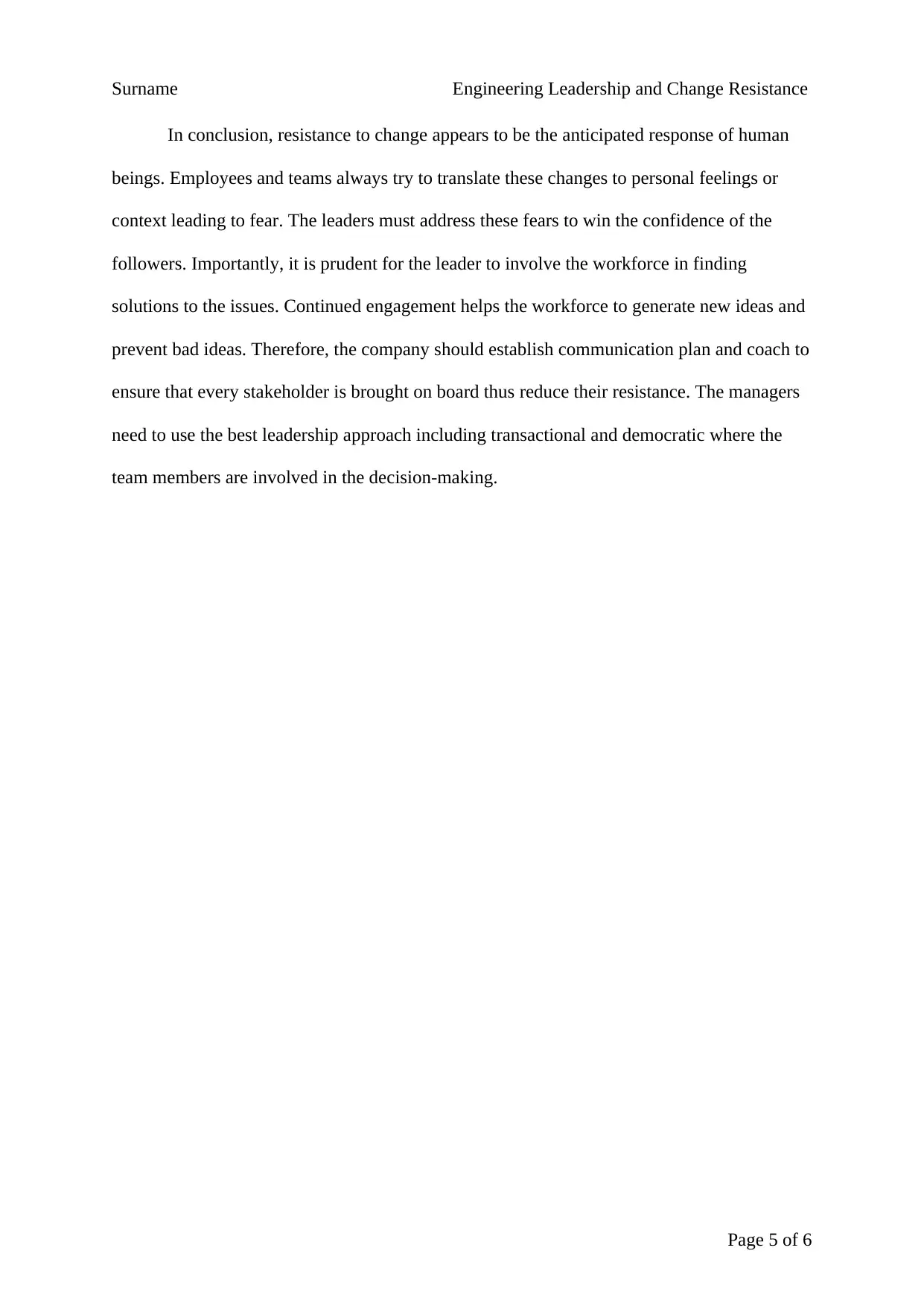
Surname Engineering Leadership and Change Resistance
In conclusion, resistance to change appears to be the anticipated response of human
beings. Employees and teams always try to translate these changes to personal feelings or
context leading to fear. The leaders must address these fears to win the confidence of the
followers. Importantly, it is prudent for the leader to involve the workforce in finding
solutions to the issues. Continued engagement helps the workforce to generate new ideas and
prevent bad ideas. Therefore, the company should establish communication plan and coach to
ensure that every stakeholder is brought on board thus reduce their resistance. The managers
need to use the best leadership approach including transactional and democratic where the
team members are involved in the decision-making.
Page 5 of 6
In conclusion, resistance to change appears to be the anticipated response of human
beings. Employees and teams always try to translate these changes to personal feelings or
context leading to fear. The leaders must address these fears to win the confidence of the
followers. Importantly, it is prudent for the leader to involve the workforce in finding
solutions to the issues. Continued engagement helps the workforce to generate new ideas and
prevent bad ideas. Therefore, the company should establish communication plan and coach to
ensure that every stakeholder is brought on board thus reduce their resistance. The managers
need to use the best leadership approach including transactional and democratic where the
team members are involved in the decision-making.
Page 5 of 6
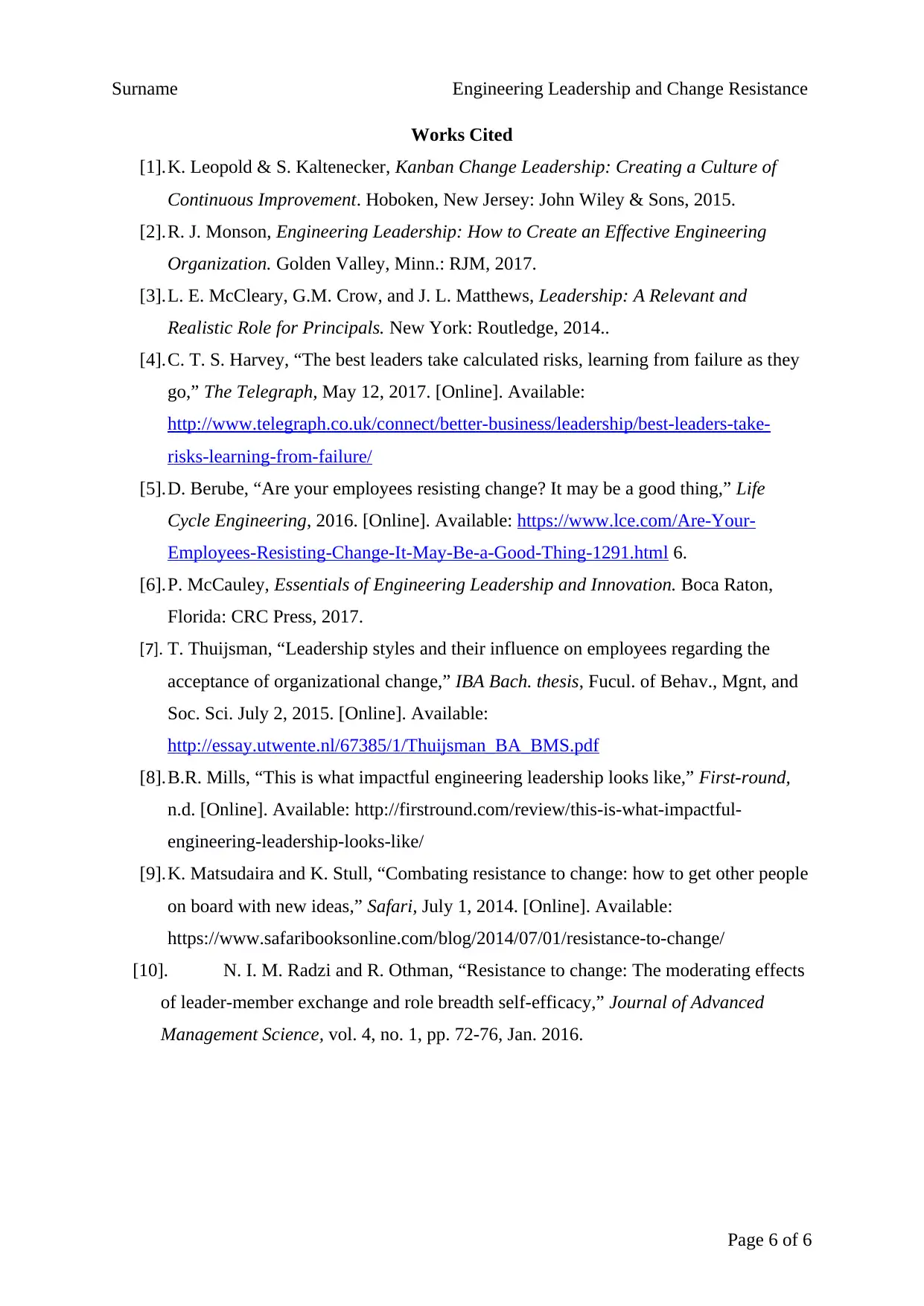
Surname Engineering Leadership and Change Resistance
Works Cited
[1].K. Leopold & S. Kaltenecker, Kanban Change Leadership: Creating a Culture of
Continuous Improvement. Hoboken, New Jersey: John Wiley & Sons, 2015.
[2].R. J. Monson, Engineering Leadership: How to Create an Effective Engineering
Organization. Golden Valley, Minn.: RJM, 2017.
[3].L. E. McCleary, G.M. Crow, and J. L. Matthews, Leadership: A Relevant and
Realistic Role for Principals. New York: Routledge, 2014..
[4].C. T. S. Harvey, “The best leaders take calculated risks, learning from failure as they
go,” The Telegraph, May 12, 2017. [Online]. Available:
http://www.telegraph.co.uk/connect/better-business/leadership/best-leaders-take-
risks-learning-from-failure/
[5].D. Berube, “Are your employees resisting change? It may be a good thing,” Life
Cycle Engineering, 2016. [Online]. Available: https://www.lce.com/Are-Your-
Employees-Resisting-Change-It-May-Be-a-Good-Thing-1291.html 6.
[6].P. McCauley, Essentials of Engineering Leadership and Innovation. Boca Raton,
Florida: CRC Press, 2017.
[7]. T. Thuijsman, “Leadership styles and their influence on employees regarding the
acceptance of organizational change,” IBA Bach. thesis, Fucul. of Behav., Mgnt, and
Soc. Sci. July 2, 2015. [Online]. Available:
http://essay.utwente.nl/67385/1/Thuijsman_BA_BMS.pdf
[8].B.R. Mills, “This is what impactful engineering leadership looks like,” First-round,
n.d. [Online]. Available: http://firstround.com/review/this-is-what-impactful-
engineering-leadership-looks-like/
[9].K. Matsudaira and K. Stull, “Combating resistance to change: how to get other people
on board with new ideas,” Safari, July 1, 2014. [Online]. Available:
https://www.safaribooksonline.com/blog/2014/07/01/resistance-to-change/
[10]. N. I. M. Radzi and R. Othman, “Resistance to change: The moderating effects
of leader-member exchange and role breadth self-efficacy,” Journal of Advanced
Management Science, vol. 4, no. 1, pp. 72-76, Jan. 2016.
Page 6 of 6
Works Cited
[1].K. Leopold & S. Kaltenecker, Kanban Change Leadership: Creating a Culture of
Continuous Improvement. Hoboken, New Jersey: John Wiley & Sons, 2015.
[2].R. J. Monson, Engineering Leadership: How to Create an Effective Engineering
Organization. Golden Valley, Minn.: RJM, 2017.
[3].L. E. McCleary, G.M. Crow, and J. L. Matthews, Leadership: A Relevant and
Realistic Role for Principals. New York: Routledge, 2014..
[4].C. T. S. Harvey, “The best leaders take calculated risks, learning from failure as they
go,” The Telegraph, May 12, 2017. [Online]. Available:
http://www.telegraph.co.uk/connect/better-business/leadership/best-leaders-take-
risks-learning-from-failure/
[5].D. Berube, “Are your employees resisting change? It may be a good thing,” Life
Cycle Engineering, 2016. [Online]. Available: https://www.lce.com/Are-Your-
Employees-Resisting-Change-It-May-Be-a-Good-Thing-1291.html 6.
[6].P. McCauley, Essentials of Engineering Leadership and Innovation. Boca Raton,
Florida: CRC Press, 2017.
[7]. T. Thuijsman, “Leadership styles and their influence on employees regarding the
acceptance of organizational change,” IBA Bach. thesis, Fucul. of Behav., Mgnt, and
Soc. Sci. July 2, 2015. [Online]. Available:
http://essay.utwente.nl/67385/1/Thuijsman_BA_BMS.pdf
[8].B.R. Mills, “This is what impactful engineering leadership looks like,” First-round,
n.d. [Online]. Available: http://firstround.com/review/this-is-what-impactful-
engineering-leadership-looks-like/
[9].K. Matsudaira and K. Stull, “Combating resistance to change: how to get other people
on board with new ideas,” Safari, July 1, 2014. [Online]. Available:
https://www.safaribooksonline.com/blog/2014/07/01/resistance-to-change/
[10]. N. I. M. Radzi and R. Othman, “Resistance to change: The moderating effects
of leader-member exchange and role breadth self-efficacy,” Journal of Advanced
Management Science, vol. 4, no. 1, pp. 72-76, Jan. 2016.
Page 6 of 6
⊘ This is a preview!⊘
Do you want full access?
Subscribe today to unlock all pages.

Trusted by 1+ million students worldwide
1 out of 6
Related Documents
Your All-in-One AI-Powered Toolkit for Academic Success.
+13062052269
info@desklib.com
Available 24*7 on WhatsApp / Email
![[object Object]](/_next/static/media/star-bottom.7253800d.svg)
Unlock your academic potential
Copyright © 2020–2025 A2Z Services. All Rights Reserved. Developed and managed by ZUCOL.





